The All Whites may be considered minnows on the world stage but they are the strongest nation in the Oceania Football Federation, especially at that time their previous powerhouse Australia recently transferred administration to its Asian counterpart so they could face stronger opposition.
Despite originally playing in the same shade as their renowned rugby union compatriots back in the day, they went to the other side of the scale to give themselves a distinct identity, hence the nickname. The change was also apparently compounded by black initially being reserved for the match officials.
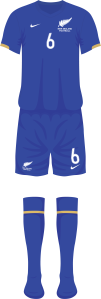

Nike have supplied the Kiwis since 2004 and it was with their latest templates; with the 2006 release similar to what the likes of Brazil, the Netherlands and their rivals across Tasman Sea would showcase at the upcoming World Cup in Germany.
Now that the referees have a wider palette to choose from, black has since came back into New Zealand’s laundry hamper though as their backup. Before that, the American firm fitted them in blue for the road.
When its Total 90 precursor reached its shelf life, the much cleaner replacement — with gold trim on the sleeves and socks — made its debut against Chile in two friendlies in the space of three days in late April. Black still featured on the outfit but on the appliqués.

Like with the premium teams, player names were present all in Nike’s new typeface.
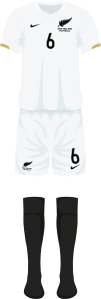
Although owing to the host’s white socks, the new kit’s first two appearances made them be in black. A little tour in Europe a month later saw it in its proper ensemble, first versus Hungary.
Whilst what was worn in Chile was seen against Estonia over a week later, it’s hard to find much information about the game with Georgia in between. The Caucasian nation also wore white at the time but asking The Ultimate New Zealand Soccer Website, they suggested black but more on that later…
Other white-socked opponents was up next, who were none other than la Seleção warming up to defend their world title. Despite the clashing stockings, both wore their white pairs.
In goal, yellow looked like to be the primary choice, in Nike’s halved raglan template. Black and grey were in reserve.

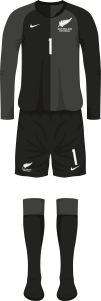

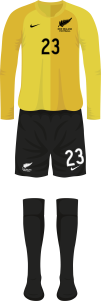
However, the black bottoms were paired with those black shorts and the matching alternate outfield socks along with the yellow shirt in the encounter with Estonia.
In August, it was a return to Europe to play in some unofficial friendlies against club sides, who were preparing for their domestic seasons.
Charlton Athletic were up first and despite the quirkiness of the fixture, there wasn’t much but up next was a trip up north in England to take on Blackburn Rovers.

With the home team’s blue-and-white halves, the visitors had to repurpose their all-black training kit, which could have been the aforementioned Georgia strip.

The contingency measure here was to such an extent that they used a different style of numbers with no names, looking more like their oval-shaped brethren, who sport Adidas wears by the way.
After that was a trip to Spain to face UEFA Cup holders Sevilla, when they were holding their first title, allowing the Kiwis’ blue change uniform to get its first known outing.
New Zealand’s men wouldn’t be in action again until March 2007, with friendlies against Costa Rica and then Venezuela, sporting their usual colours but two months later, they travelled to Wales.
Celebrating 130 years of the oldest surviving international venue, the Racecourse Ground in Wrexham, the hosts celebrated the occasion with a special white strip thus making them be equipped in blue — the first time in an official capacity.
Next up was their first competitive game in four years; Fiji in the OFC Nations Cup on 17 October, which doubled up as the Second Round of the region’s qualifiers for the 2010 FIFA World Cup.
Blue was worn again then but for its last time. Those two should have played each other four days earlier but the initial fixture at home was postponed by over a year due to a visa issue with the opposition goalkeeper.
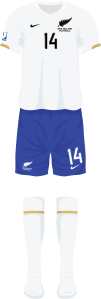
In the meantime, their youth teams participated in the under-20 and under-17 World Cups over the summer, where the blue away got far more exposure. At the U17 championship, the white kit with blue shorts was seen against North Korea.
Back to the senior squad and a month after the Fiji tie, it was a double header with Vanuatu in the continental competition that worked as a mini league/group stage, depending if you look at it from a regional or global perspective.
New Caledonia were their opponents in the same tournament but that being the following September, new kits were launch. The away would be back to being all-black and that was the one which made its debut of the fresh batch, which is how the backup has been since for the New Zealanders.
For the record, the corresponding home was an inverse of that as they won the Nations Cup and then the subsequent intercontinental play-off, qualifying for their second ever World Cup where the Kiwis ended up being the only unbeaten country at South Africa 2010.